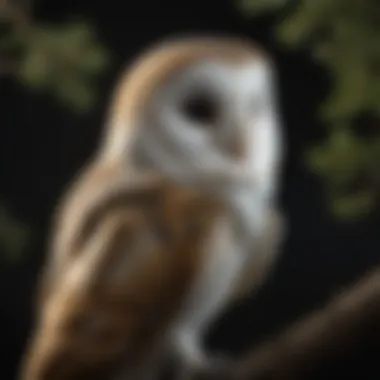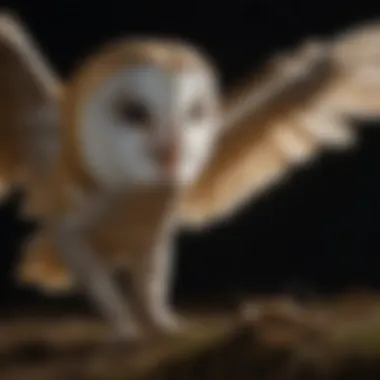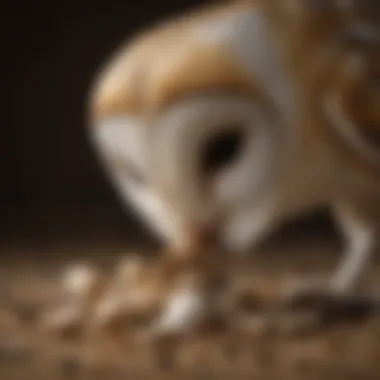Exploring the Dietary Habits of Barn Owls: A Fascinating Analysis of their Prey


Animal Species Profile
Barn owls are fascinating nocturnal predators that exhibit a diverse range of dietary habits. With their silent flight and keen sense of hearing, these majestic creatures are able to hunt a variety of prey including small rodents and insects. Their ecological role as efficient hunters plays a crucial part in maintaining the balance of their ecosystem. Barn owls are known for their distinctive heart-shaped facial discs and soft plumage, which enable them to fly swiftly and hunt with precision. These birds are predominantly found in open grasslands, meadows, and agricultural fields, preferring areas with abundant prey populations. In terms of behavior, barn owls are solitary hunters, coming together only during breeding season to raise their young.
Unique Facts & Trivia
Despite their silent flight, barn owls are not completely noiseless; their wings produce a rustling sound due to the feather structure. One interesting fact about barn owls is they have asymmetrical ears placed at different heights on their heads, allowing them to pinpoint the exact location of prey by sound alone. Additionally, barn owls are capable of rotating their heads up to 270 degrees, aiding in their efficient hunting. These birds also exhibit monogamous behavior, forming strong pair bonds that last a lifetime. Barn owls have been known to exhibit remarkable adaptability, thriving in various habitats ranging from temperate forests to deserts, showcasing their resilience and survival skills.
Introduction
In the realm of avian predators, barn owls stand out as fascinating creatures graced with unique characteristics that set them apart from other raptors. Their dietary habits offer a captivating lens through which to view their role in the ecosystem and their specialized hunting techniques. By delving into the dietary preferences of barn owls, we can unravel the intricate connections between these nocturnal hunters and their prey, shedding light on the delicate balance of nature.
Understanding Barn Owls
Barn owls, with their heart-shaped faces and distinct white plumage, are admired for their ethereal beauty and predatory prowess. One key aspect defining barn owls is their exceptional physical characteristics, tailored for silent flight and swift hunting maneuvers. The ability of barn owls to navigate the night skies with minimal sound, thanks to their unique wing structure, amplifies their effectiveness as hunters. Their mastery of silent flight has been honed through evolution, making them formidable nocturnal predators.
When it comes to habitat and distribution, barn owls are adaptable creatures found in various regions across the globe. Their penchant for diverse habitats, ranging from farmlands to grasslands, showcases their ability to thrive in different ecosystems. This adaptability reflects in their distribution patterns, highlighting their widespread presence in both rural and urban settings. Despite facing challenges in some areas due to habitat loss, barn owls exhibit resilience in adjusting to human-modified landscapes.
Barn Owls: Nocturnal Hunters
In this article, we delve into the fascinating world of Barn Owls as nocturnal hunters. These magnificent creatures have evolved remarkable adaptations that enable them to thrive in the darkness of the night. Understanding the hunting behaviors and unique characteristics of Barn Owls is crucial to unraveling their ecological significance and survival strategies.
Nocturnal Adaptations
Silent Flight Mechanism
The Silent Flight Mechanism of Barn Owls is a remarkable adaptation that sets them apart from other raptors. This specialized trait allows them to fly almost silently, making them formidable hunters under the cloak of darkness. By reducing noise during flight, Barn Owls can sneak up on their prey with unmatched stealth, showcasing their efficient and precise hunting capabilities. This unique feature plays a pivotal role in their nocturnal hunting success, emphasizing the evolutionary marvel of these avian predators.


Enhanced Night Vision
Barn Owls possess exceptional night vision, a key adaptation that enhances their hunting prowess in low-light conditions. Their eyes are finely tuned to perceive even the slightest movements of potential prey in the dark, giving them a strategic advantage during nocturnal hunting expeditions. The enhanced night vision of Barn Owls underscores their adaptability to hunting in environments where visibility is limited, showcasing their evolutionary agility and predatory acumen.
Hunting Behavior
Stealthy Approach to Prey
The stealthy approach to prey is a critical hunting behavior exhibited by Barn Owls, allowing them to stalk their victims undetected. With their silent flight mechanism and keen eyesight, Barn Owls can approach unsuspecting prey with unparalleled precision, making them efficient and deadly hunters. This methodical and calculated approach underscores the strategic intelligence of Barn Owls in securing their next meal, revealing a harmonious blend of instinct and skill in their hunting repertoire.
Pounce and Capture Techniques
Barn Owls deploy swift pounce and capture techniques to seize their prey with swift and decisive movements. Once they have identified a target, Barn Owls swiftly dive down with pinpoint accuracy, using their sharp talons to secure their meal. This rapid and effective hunting strategy highlights the agility and hunting prowess of these magnificent birds of prey. By mastering the pounce and capture techniques, Barn Owls showcase their predatory finesse, ensuring successful hunts in their nocturnal realm.
Dietary Preferences of Barn Owls
Exploring the Dietary Habits of Barn Owls delves into the crucial aspect of understanding what these majestic birds prefer to consume. By unraveling their dietary preferences, we gain a deeper insight into the ecological dynamics of barn owls. This section sheds light on the specific elements that influence their prey selection, highlighting key benefits and considerations that shape their feeding habits.
Primary Prey of Barn Owls
Small Mammals
In the realm of barn owl dietary habits, small mammals play a pivotal role as a significant source of sustenance. These creatures, ranging from rodents to shrews, contribute significantly to the overall diet of barn owls, providing essential nutrients and energy. The key characteristic of small mammals lies in their abundance and accessibility, making them a popular choice for barn owls. Their unique feature, which offers a high protein content, aligns perfectly with the nutritional needs of these nocturnal hunters, enhancing their hunting success.
Birds
Birds also form a crucial part of the barn owl's dietary spectrum, adding diversity to their prey selection. The consumption of birds by barn owls signifies a strategic choice based on varied nutritional profiles and hunting efficiencies. The key characteristic of birds as prey stems from their mobility and visibility, presenting a rewarding target for barn owls during nocturnal hunts. Despite the advantages of avian prey, challenges like swift flight patterns can pose difficulties for barn owl predation in certain instances.
Insects


Insects offer a supplementary yet essential component in the dietary preferences of barn owls. While comparatively smaller in size, insects contribute valuable nutrients and vitamins to the owl's diet. The key characteristic of insects lies in their abundance during specific seasons, making them a convenient dietary option for barn owls to maintain energy levels. However, the reduced caloric value of insects compared to mammals and birds necessitates a higher intake volume to meet the owl's nutritional requirements.
Seasonal Variations in Diet
Impact of Breeding Season
Seasonal changes, especially during breeding periods, significantly influence the dietary habits of barn owls. The availability of prey species alters according to breeding seasons, impacting the types of food sources accessible to these birds. The key characteristic of the impact of breeding season lies in the increased nutritional demands required for rearing offspring, prompting barn owls to adjust their hunting strategies and prey selection accordingly. While breeding periods present abundant hunting opportunities, they also introduce competition for resources among barn owl populations.
Availability of Prey Species
The fluctuating availability of prey species throughout the year plays a crucial role in shaping the diet of barn owls. As environmental factors influence the distribution and abundance of prey, barn owls navigate through varying food sources to meet their nutritional requirements. The key characteristic of prey availability underscores the dynamic nature of owl diets, indicating a strategic adaptation to ensure survival. While seasonal variations pose challenges in maintaining a consistent food supply, barn owls exhibit flexibility in prey selection to sustain their physiological needs.
Factors Influencing Prey Selection
In the realm of barn owls' dietary habits, understanding the factors that influence their prey selection is paramount. These factors play a crucial role in shaping the barn owls' foraging behavior and survival strategies. By examining the ecological and physiological aspects of prey selection, we can unravel the intricate dynamics of their hunting patterns and ecosystem interactions. The interplay between environmental conditions, prey availability, and internal nutritional needs guides the barn owls in selecting their prey items.
Ecological Considerations
Prey Abundance in Habitat
Delving into the concept of prey abundance in the barn owl's habitat provides valuable insights into their dietary choices. The prevalence of suitable prey species within their hunting grounds significantly impacts the barn owls' feeding patterns and energy expenditure. An environment rich in small mammals and birds offers a bounty of food sources for the barn owls, allowing them to fulfill their nutritional requirements efficiently. However, fluctuations in prey populations can pose challenges for these nocturnal predators, affecting their hunting success and overall health.
Impact on Ecosystem Dynamics
The influence of barn owls on ecosystem dynamics is profound, emphasizing the intricate balance between predator and prey relationships. By preying on rodents and other small mammals, barn owls help regulate population levels and maintain ecosystem equilibrium. This predatory role contributes to preserving vegetation and preventing agricultural damage caused by excessive rodent populations. However, alterations in barn owl populations can trigger ripple effects throughout the ecosystem, affecting biodiversity and trophic interactions.
Physiological Factors


Nutritional Requirements
The nutritional requirements of barn owls are closely linked to their hunting behavior and prey selection. A diet rich in proteins and essential nutrients is vital for their growth, reproduction, and overall well-being. By consuming a diverse range of prey items, barn owls can obtain the necessary vitamins and minerals to sustain their metabolic activities and physiological functions. The intricate balance between energy intake and expenditure dictates the barn owls' foraging strategies and dietary preferences.
Digestive Adaptations
Exploring the digestive adaptations of barn owls sheds light on their remarkable ability to process diverse prey items efficiently. From regurgitating pellets containing indigestible materials to maximizing nutrient absorption, barn owls have evolved specialized digestive systems suited for their carnivorous lifestyle. These adaptations enable barn owls to extract maximum nutrition from their prey, optimizing their digestive processes and energy utilization. Understanding the intricacies of their digestive adaptations enhances our appreciation for the barn owl's efficiency as nocturnal hunters.
Interactions with Human Activities
In the intricate ecosystem where barn owls thrive, their interactions with human activities play a crucial role. Understanding how human actions impact these majestic birds sheds light on conservation efforts and agricultural dynamics. One particular aspect to delve into is the agricultural impact on barn owl populations.
Agricultural Impact
Within the realm of barn owl conservation, the agricultural industry intertwines closely with these nocturnal predators. Two key facets to explore are the rodent control benefits and crop damage concerns linked to barn owl presence. Let's dissect these elements further.
Rodent Control Benefits
A pivotal role barn owls play in agricultural settings is their adeptness at rodent control. Farm owners and managers recognize the value of barn owls in naturally managing rodent populations that can wreak havoc on crops. The key characteristic lies in the owl's voracious appetite for rodents, acting as a biological pest control method. This eco-friendly approach reduces the reliance on chemical pesticides, promoting a more sustainable farming environment. Despite their nocturnal nature, barn owls' silent flight and precise hunting skills make them efficient rodent eliminators.
Crop Damage Concerns
On the flip side, concerns arise regarding potential crop damage associated with barn owl activities. While their presence benefits crop protection through pest reduction, there are instances where barn owls may inadvertently cause minor crop damage during hunting pursuits. However, the benefits of rodent control often outweigh these concerns. Understanding the delicate balance between conservation efforts and agricultural interests is vital for ensuring the coexistence of barn owls and farming practices.
Conservation Perspectives
Examining barn owls from a conservation perspective unveils their intricate role in maintaining ecosystem balance. Their presence in natural habitats contributes to biodiversity and ecological stability, offering a unique viewpoint on wildlife conservation.
Role in Maintaining Ecosystem Balance
As barn owls maintain balanced predator-prey dynamics, they aid in controlling small mammal populations that can otherwise spiral out of control. By keeping rodent numbers in check, barn owls prevent ecological imbalances that could adversely affect plant species and agricultural productivity. Their crucial role as natural pest controllers underscores their significance in upholding ecosystem equilibrium.
Threats to Barn Owl Populations
Despite their ecological importance, barn owl populations face threats that endanger their survival. Habitat loss, pesticide exposure, and human disturbance pose significant risks to these nocturnal predators. Understanding these threats is imperative in formulating conservation strategies to mitigate adverse effects on barn owl populations. By addressing these challenges, we strive to safeguard the future of these remarkable birds.







